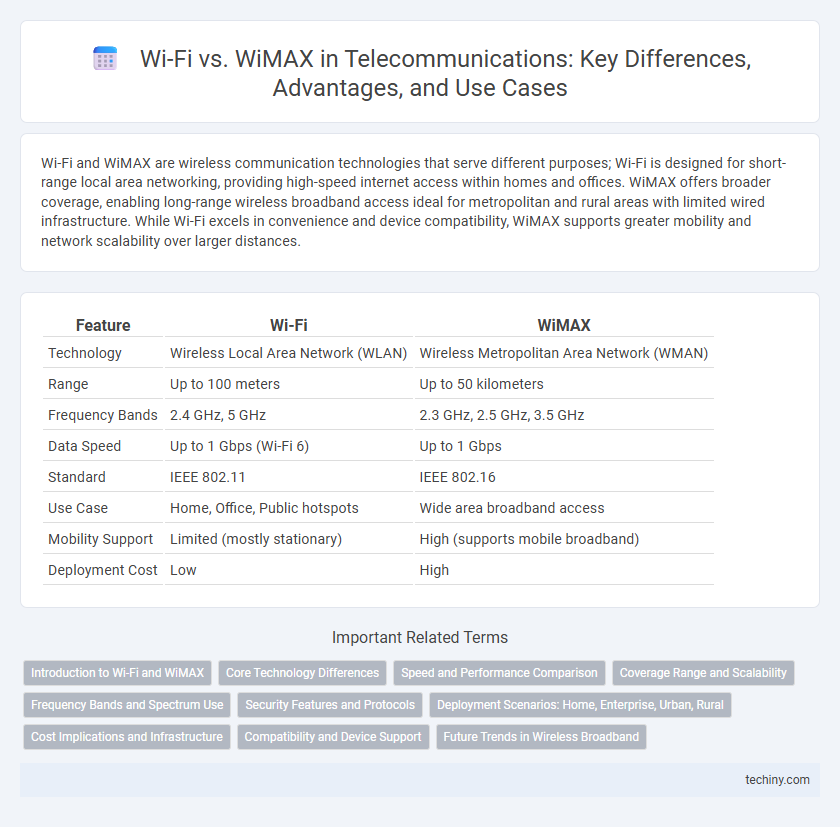Wi-Fi and WiMAX are wireless communication technologies that serve different purposes; Wi-Fi is designed for short-range local area networking, providing high-speed internet access within homes and offices. WiMAX offers broader coverage, enabling long-range wireless broadband access ideal for metropolitan and rural areas with limited wired infrastructure. While Wi-Fi excels in convenience and device compatibility, WiMAX supports greater mobility and network scalability over larger distances.
Table of Comparison
| Feature | Wi-Fi | WiMAX |
|---|---|---|
| Technology | Wireless Local Area Network (WLAN) | Wireless Metropolitan Area Network (WMAN) |
| Range | Up to 100 meters | Up to 50 kilometers |
| Frequency Bands | 2.4 GHz, 5 GHz | 2.3 GHz, 2.5 GHz, 3.5 GHz |
| Data Speed | Up to 1 Gbps (Wi-Fi 6) | Up to 1 Gbps |
| Standard | IEEE 802.11 | IEEE 802.16 |
| Use Case | Home, Office, Public hotspots | Wide area broadband access |
| Mobility Support | Limited (mostly stationary) | High (supports mobile broadband) |
| Deployment Cost | Low | High |
Introduction to Wi-Fi and WiMAX
Wi-Fi is a wireless networking technology that enables devices to connect to the internet and communicate within a local area using radio waves, typically operating in the 2.4 GHz and 5 GHz frequency bands. WiMAX (Worldwide Interoperability for Microwave Access) provides broadband wireless access over longer distances, supporting metropolitan area networks with higher data rates and greater range, often using frequencies between 2.3 GHz and 3.5 GHz. Both technologies serve different use cases: Wi-Fi focuses on short-range connectivity for home and office environments, while WiMAX targets wide-area wireless internet access.
Core Technology Differences
Wi-Fi operates primarily on IEEE 802.11 standards, using unlicensed spectrum bands like 2.4 GHz and 5 GHz for short-range wireless local area networking, ideal for indoor environments. WiMAX utilizes IEEE 802.16 standards, leveraging licensed spectrum to deliver broadband access over longer distances with higher throughput and better Quality of Service (QoS) management. Core technology differences include Wi-Fi's focus on localized connectivity with mesh networking capabilities versus WiMAX's point-to-multipoint architecture designed for metropolitan area networks and last-mile broadband solutions.
Speed and Performance Comparison
Wi-Fi typically offers speeds ranging from 54 Mbps with 802.11g to over 1 Gbps with the latest 802.11ax (Wi-Fi 6) standard, catering primarily to short-range indoor connectivity. WiMAX, designed for wide-area broadband access, supports speeds up to 70 Mbps over longer distances, making it suitable for urban and rural fixed wireless applications. While Wi-Fi excels in high-speed, low-latency local network environments, WiMAX provides broader coverage with moderate speed, optimizing performance based on deployment scenarios.
Coverage Range and Scalability
WiMAX offers significantly greater coverage range than Wi-Fi, with the ability to provide broadband access over distances up to 30 miles (50 kilometers) compared to Wi-Fi's typical range of 100 to 300 feet (30 to 100 meters). WiMAX supports scalability for large-scale deployments, making it ideal for metropolitan area networks (MANs) and wireless backhaul, while Wi-Fi is more suited to localized environments such as homes, offices, and hotspots. The scalability of WiMAX enables efficient management of thousands of users across wide geographic areas, contrasting with Wi-Fi's capacity limitations in densely populated scenarios.
Frequency Bands and Spectrum Use
Wi-Fi primarily operates in the unlicensed 2.4 GHz and 5 GHz frequency bands, offering greater flexibility for indoor and short-range wireless communication. WiMAX utilizes licensed frequency bands, including 2.3 GHz, 2.5 GHz, and 3.5 GHz, enabling long-range, high-capacity broadband access with better interference management. The distinct spectrum usage of Wi-Fi and WiMAX impacts their deployment scenarios, with Wi-Fi favoring local area networks and WiMAX targeting metropolitan area networks.
Security Features and Protocols
Wi-Fi security relies on protocols such as WPA3, offering robust encryption with AES and enhanced protection against password guessing attacks, making it suitable for local area networks. WiMAX employs advanced encryption standards including AES and supports EAP authentication methods, providing strong security for wide-area wireless broadband access. Both technologies implement mutual authentication and key management, but WiMAX's design emphasizes scalability and security over larger coverage areas compared to Wi-Fi's focus on smaller, localized environments.
Deployment Scenarios: Home, Enterprise, Urban, Rural
Wi-Fi excels in home and enterprise deployments due to its ease of setup, short-range coverage, and high data throughput suited for indoor environments. WiMAX dominates urban and rural deployments by providing extensive wireless broadband coverage across several kilometers, ideal for wide-area networks lacking wired infrastructure. Enterprises in urban areas often integrate Wi-Fi for indoor connectivity while leveraging WiMAX for backhaul and last-mile access in remote or underserved locations.
Cost Implications and Infrastructure
Wi-Fi typically incurs lower initial setup costs due to its reliance on existing local area network equipment, making it suitable for small-scale deployments. WiMAX requires substantial investment in base stations and licensed spectrum, driving higher infrastructure expenses but offering broader coverage and better support for mobile users. Operational costs vary as WiMAX demands ongoing spectrum fees and maintenance of wide-area infrastructure, whereas Wi-Fi benefits from simpler, localized management and free unlicensed spectrum use.
Compatibility and Device Support
Wi-Fi operates on widely supported frequency bands such as 2.4 GHz and 5 GHz, ensuring compatibility with a vast array of devices including smartphones, laptops, and smart home gadgets. WiMAX, utilizing the 3.5 GHz and 5.8 GHz bands, faces more limited device support primarily from specialized routers and fixed wireless terminals. The broad device ecosystem of Wi-Fi results in superior accessibility and user convenience compared to the relatively niche compatibility of WiMAX technology.
Future Trends in Wireless Broadband
WiMAX technology is expected to evolve with enhanced range and speed, targeting wide-area wireless broadband deployment, especially in underserved rural regions. Wi-Fi advancements focus on higher throughput, lower latency, and better support for numerous connected devices within localized environments like homes and businesses. The integration of Wi-Fi 6 and WiMAX 2.1 standards will drive the convergence of wireless networks, optimizing seamless connectivity and supporting emerging applications such as IoT and smart city infrastructure.
Wi-Fi vs WiMAX Infographic

 techiny.com
techiny.com